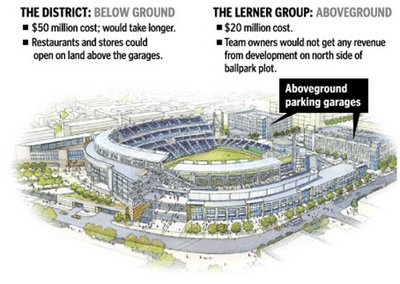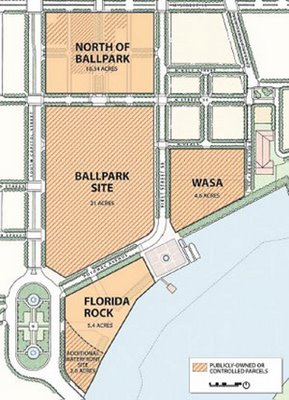 The above-ground
The above-groundversus
under-ground parking issue
As reported on the surface by both The Washington Post and The Washington Times -- in articles addressing this and the related concerns of new cost increases and the proposed creation of a new office to oversee the stadium development -- the Lerner group which purchased the Major League Baseball Washington Nationals franchise, is insisting that their stadium's parking garages be entirely aboveground.
Owners Want City to Shift Gears on Parking
http://www.washingtonpost.com/wp-dyn/content/article/2006/05/24/AR2006052402507.html
By David NakamuraWashington Post Staff Writer
Thursday, May 25, 2006; Page B04
The Washington Nationals' ownership group is pushing District officials to build massive parking garages for the baseball stadium aboveground, contrary to the wishes of city planners, who say the structures should go underground to make way for a potentially lucrative entertainment district.The outcome of the negotiations, which could be decided in a few weeks, could drastically affect the look of the ballpark area in Southeast Washington and determine whether the city, which has committed $611 million in public money to the stadium, reaps as much tax revenue from related development as promised by Mayor Anthony A. Williams (D).
Nationals Say No to Underground Parking
Early Problems
Consume Nearly Half of Contingency Fund http://www.washingtonpost.com/wp-dyn/content/article/2006/06/07/AR2006060702062.html
By David Nakamura Washington Post Staff Writer
Thursday, June 8, 2006; Page BO4
The Washington Nationals ownership group firmly told District government leaders yesterday that it expects a new baseball stadium to be completed by April 2008 with aboveground parking garages, insisting that city planners have run out of time to build parking underground to make way for an entertainment district.Mayor Creates Office to Oversea Development
http://www.washingtontimes.com/sports/20060531-115931-9275r.htm
By Tim Lemke and Amy Doolittle THE WASHINGTON TIMES
Thursday, June 1, 2006
Development of the ballpark began last month and is scheduled to be completed for Opening Day 2008. But the timeline has been threatened by squabbles that many city officials have said stems from having multiple parties with a stake in the project.
In particular, the AWC and D.C. Sports and Entertainment Commission have disagreed on how to proceed with the construction of a garage for about 1,250 cars at the site. The AWC has said it prefers an underground lot so retail and other commercial space can be built at street level. But the sports commission only has funds to build above-ground garages and said it may not be possible to build a stadium with underground parking on time and under the city's $611 million cost cap.
The Lerner family, which is expected to take over next month as the Nationals' ownership group, also said it would prefer structured garages above ground.
Incoming Nationals president Stan Kasten declined to comment on the Office of Baseball idea because he was still gathering details on the proposal. But sports commission chairman Mark Tuohey said he supported it.
"It's a good thing. ... It gets all of the principals and brings them together," he said. "I think a coordinating group makes sense." Sports commission CEO Allen Lew is expected to make a recommendation to the panel's board of directors on the parking issue next week. Some expect the commission to move forward with some parking underground and some above.
City Administrator Robert Bobb said District officials planned to meet with the Lerners and officials from the Anacostia Waterfront Corp. yesterday and today to discuss possible solutions to the parking question. He said the groups would reach an agreement about the placement of the parking structure by this afternoon and that the plans would be complete when submitted to the National Capitol Planning Commission tomorrow.Hazmat removal up by $2.9M
http://www.washtimes.com/sports/20060608-120626-4294r.htm
By Tim Lemke THE WASHINGTON TIMES
Thursday, June 8, 2006
The D.C. Sports and Entertainment Commission yesterday voted to spend an additional $2.9 million to remove hazardous materials from the site of the Washington Nationals' new ballpark in Southeast after the construction team discovered more contamination than expected.
The expenditure is on top of the $8 million already set aside for hazmat removal at the site and will be funded by a contingency built into the budget for the $611 million project.
Much of the removal work centers on large underground gas tanks left behind by previous landowners. The construction team, led by Clark Construction of Bethesda, also has encountered soil contamination and other hazardous waste left behind by a trash transfer facility, asphalt plant and a smattering of garages and automobile repair shops.Underground parking is sought to make space for ground level retail which would provide a more pleasant environment for pedestrians.
The sports commission is now looking to replenish the money taken from the contingency and could sell some development rights or get reimbursements from the federal government or other sources. The D.C. Council ruled in March the city cannot spend any more than the $611 million. Completion of the project is scheduled for March 2008.
So far, the construction team has demolished 24 buildings at the site and installed 140 of the 2,400 pilings needed to build the ballpark.
Meanwhile, the commission approved a change to its contract with the stadium construction team to allow for up to 16,000 square feet of retail space along the ballpark's facade on First Street. To allow for the development, the commission asked for changes to the design of loading docks at the site. It is still unclear whether the space will be developed by the commission, the Nationals or not at all.
The sports commission gave no update, however, regarding ongoing discussions about parking at the stadium. The commission is required to build space for about 1,200 cars on the ballpark site. The commission has only about $20 million set aside for above-ground garages, but the Anacostia Waterfront Corporation prefers below-ground parking, which is more costly, because it would allow for street-level development.
Officials from both groups and the offices of the mayor and city administrator met yesterday to work out a compromise plan, the specifics of which is expected to be revealed next week.
To work within the dictates of providing 1,200 ballpark site parking spaces, and an April 2008 opening, while providing ground level exterior retail, confining the latter to the exterior (sidewalk adjacent) first floor, would minimize parking space displacement and the need to expand underground. The following plan view that I got from Jacqueline Dupree's site shows these structures at upper left and upper right. (The upper left structure includes the space formerly occupied by the Alfred Richards House owned by Ken Wyban from 1998-2006, near the 2nd tree of the group of 4 trees at Van and N Streets SE).
The competing perspectives here are that of either saving $20 or 30 million on the short term construction costs and duration to make the scheduled April 2004 opening, or spending the extra money and having the extra space available. By any measure, underground parking would ultimately permit a greater amount of available developed square footage along the
If the increased initial expense of the underground construction is offset by the future greater amounts of perpetual revenue – IOW, if underground parking ultimately pays for itself with increased revenue -- then denying underground parking would not save money in the long term; hence insisting upon above-ground parking appears foolish
Since the most important thing about underground parking seems to be to make space for street level (sidewalk-adjacent) retail, and since the most important thing to the Lerner group appears to be to reduce short term costs and to make a scheduled April 2008 opening, the design could and should devote at least the outer portion of these structure’s ground (street level) to side-walk adjacent retail, with the upper levels for parking, hence minimizing the need for underground construction. Assuredly, the reduced amount of underground construction would be cheaper then a greater amount of such.
Yet the Lerner group reportedly opposes any proposals with any amount of underground parking
http://www.washingtonpost.com/wp-dyn/content/article/2006/06/07/AR2006060702062.htm
This blogger would like to see some figures for the comparative short term costs and long term consequences of different options, from construction costs to perpetual revenue intake, that were presumably studied by the parties involved..
It might not be written in stone that the Nationals need not inaugurate this new stadium by the scheduled April 2008 opening date, and that they could play another year or few at RFK, even indefinitely.
But with construction costs rising unexpectedly with the initial excavation only 5 weeks past groundbreaking, one has to wonder about what may lay beneath the surface to potentially increase the construction costs of the garage - hence the insistence upon ALL above-ground parking to avoid short term cost increases that could push it over budget, and potentially endanger the project.





No comments:
Post a Comment